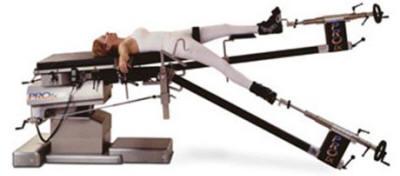Minimally invasive anterior total hip replacement is performed by Dr. Stuart Kozinn at The Scottsdale Joint Center using the HANA total hip table. The HANA table allows Dr. Kozinn to apply traction and rotation to the hip joint in order to dislocate it and expose the bone surfaces without cutting any muscles. This means you recover much, much faster, and get back to normal life as soon as possible.
 The HANA table was specifically designed by Dr. Joel Matta (from Los Angeles) with the Anterior Hip Replacement procedure in mind. It can accommodate traction in patients up to 6 foot 9 inches tall and still apply necessary traction to open the hip joint. Patients lie flat on their back, and can be asleep using general anesthesia, or more awake with a spinal anesthetic. For those who like the idea of being awake during surgery, it has a very comfortable gel cushion to rest on. Either anesthesia allows full muscle relaxation below the waist. I prefer the spinal anesthestia whenever possible as it is a safer anesthesia, and there is less pain post-operatively. Spinal anesthesia also decreases the bleeding by keeping the blood pressure lower during the surgery. The full muscle relaxation facilitates stretching the hip ligaments to allow easier hip dislocation without cutting any muscles.
The HANA table was specifically designed by Dr. Joel Matta (from Los Angeles) with the Anterior Hip Replacement procedure in mind. It can accommodate traction in patients up to 6 foot 9 inches tall and still apply necessary traction to open the hip joint. Patients lie flat on their back, and can be asleep using general anesthesia, or more awake with a spinal anesthetic. For those who like the idea of being awake during surgery, it has a very comfortable gel cushion to rest on. Either anesthesia allows full muscle relaxation below the waist. I prefer the spinal anesthestia whenever possible as it is a safer anesthesia, and there is less pain post-operatively. Spinal anesthesia also decreases the bleeding by keeping the blood pressure lower during the surgery. The full muscle relaxation facilitates stretching the hip ligaments to allow easier hip dislocation without cutting any muscles.
What are the benefits of using the HANA table for anterior total hip replacement?
- Less Pain because there’s no need to cut muscles.
- Lower Dislocation Risk because fewer ligaments are Cut.
- Reduced Risk of implant mal-positioning and leg length inequality.
- It’s possible to leave the hospital the SAME day of your surgery.
The table has infinite degrees of freedom to allow positioning of the femoral neck in space. This is because universal ball joints are present at the ankle and at the leg attachment to the main table for each leg. The joints can be frozen instantaneously and locked in any position by an ingenious clamp system.
Using a motor controlled by an anesthesiologist, the table can tilt to a head down position, allowing the operative foot to be positioned on the floor and under the other leg. This externally rotates the femur and swings its top out of the wound into clear view. The table then holds it there, while the surgeon uses an electric foot switch to raise a “bone hook” inside the wound, further lifting the femur into view. The rasp system allows placement of the femoral implant without interference from any soft tissue.It is actually quite fun to run the table, much like a crane operator picks up his target load!).
The hip is extremely stable during the procedure because no muscles have been cut or lengthened, and only a third or so of the hip ligaments have been opened. The table acts like a silent assistant (or two!), and doesn’t get tired or need to take breaks. In fact, I am pretty sure i could do the case all by myself, as long as an unscrubbed helper set the table positions as needed.